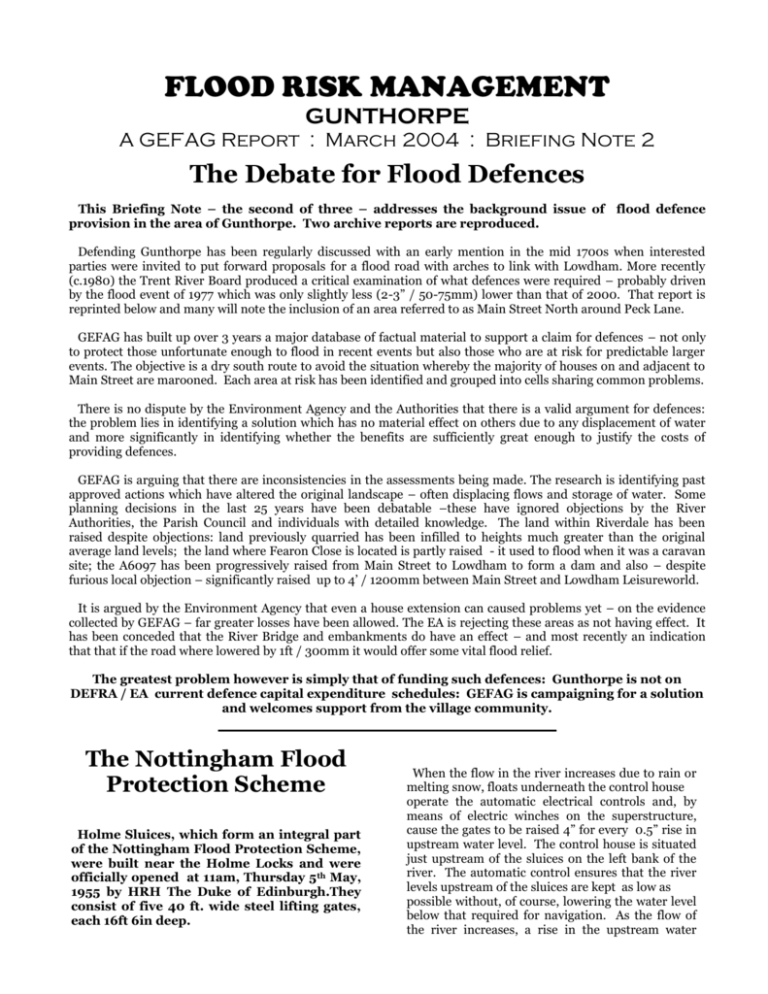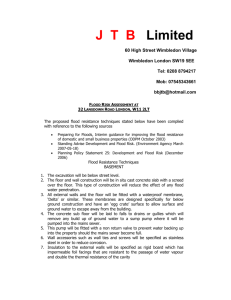The Nottingham Flood Protection Scheme Briefing Note 2 Version
advertisement

The sluices replaced the old Colwick weir and were designed to maintain a difference in water level of approximately 10ft at low summer flows. FLOOD RISK MANAGEMENT GUNTHORPE A GEFAG Report : March 2004 : Briefing Note 2 The Debate for Flood Defences This Briefing Note – the second of three – addresses the background issue of flood defence provision in the area of Gunthorpe. Two archive reports are reproduced. Defending Gunthorpe has been regularly discussed with an early mention in the mid 1700s when interested parties were invited to put forward proposals for a flood road with arches to link with Lowdham. More recently (c.1980) the Trent River Board produced a critical examination of what defences were required – probably driven by the flood event of 1977 which was only slightly less (2-3” / 50-75mm) lower than that of 2000. That report is reprinted below and many will note the inclusion of an area referred to as Main Street North around Peck Lane. GEFAG has built up over 3 years a major database of factual material to support a claim for defences – not only to protect those unfortunate enough to flood in recent events but also those who are at risk for predictable larger events. The objective is a dry south route to avoid the situation whereby the majority of houses on and adjacent to Main Street are marooned. Each area at risk has been identified and grouped into cells sharing common problems. There is no dispute by the Environment Agency and the Authorities that there is a valid argument for defences: the problem lies in identifying a solution which has no material effect on others due to any displacement of water and more significantly in identifying whether the benefits are sufficiently great enough to justify the costs of providing defences. GEFAG is arguing that there are inconsistencies in the assessments being made. The research is identifying past approved actions which have altered the original landscape – often displacing flows and storage of water. Some planning decisions in the last 25 years have been debatable –these have ignored objections by the River Authorities, the Parish Council and individuals with detailed knowledge. The land within Riverdale has been raised despite objections: land previously quarried has been infilled to heights much greater than the original average land levels; the land where Fearon Close is located is partly raised - it used to flood when it was a caravan site; the A6097 has been progressively raised from Main Street to Lowdham to form a dam and also – despite furious local objection – significantly raised up to 4’ / 1200mm between Main Street and Lowdham Leisureworld. It is argued by the Environment Agency that even a house extension can caused problems yet – on the evidence collected by GEFAG – far greater losses have been allowed. The EA is rejecting these areas as not having effect. It has been conceded that the River Bridge and embankments do have an effect – and most recently an indication that that if the road where lowered by 1ft / 300mm it would offer some vital flood relief. The greatest problem however is simply that of funding such defences: Gunthorpe is not on DEFRA / EA current defence capital expenditure schedules: GEFAG is campaigning for a solution and welcomes support from the village community. The Nottingham Flood Protection Scheme Holme Sluices, which form an integral part of the Nottingham Flood Protection Scheme, were built near the Holme Locks and were officially opened at 11am, Thursday 5 th May, 1955 by HRH The Duke of Edinburgh.They consist of five 40 ft. wide steel lifting gates, each 16ft 6in deep. When the flow in the river increases due to rain or melting snow, floats underneath the control house operate the automatic electrical controls and, by means of electric winches on the superstructure, cause the gates to be raised 4” for every 0.5” rise in upstream water level. The control house is situated just upstream of the sluices on the left bank of the river. The automatic control ensures that the river levels upstream of the sluices are kept as low as possible without, of course, lowering the water level below that required for navigation. As the flow of the river increases, a rise in the upstream water level of 2ft. will correspond to the gates being raised 18ft above the cill. At this stage a secondary automatic control comes into operation and the sluice gates are lifted a further 6ft. – completely clear of the water level, thereby allowing an unobstructed river flow. When the river levels begin to fall again the reverse happens. Water level indicators are installed in the control house to show on dials the river levels both upstream and downstream of the sluices and to record both levels on a recording chart. The electrical mechanism has two alarm circuits: one to sound an alarm bell if the electricity supply should fail; the other to operate a second alarm bell in the event of any electrical or mechanical failure causing the relative positions of the gate opening and the upstream water level to be ‘out of step’. The raising or lowering of any of the five sluices can also be carried out by an alternative ‘push button’ control either from the control house or from the superstructure. In the control house a standby electrical generator is provided in case of a failure in the electrical supply. As a further safeguard the sluices can be normally operated from the superstructure girders. The sluices are part of works comprising the Nottingham Flood Protection Scheme which extends for a length of approximately 10 river miles. The scheme was designed to prevent flooding from the River Trent in the City of Nottingham and the Urban Districts of Beeston, West Bridgford and Carlton and the parishes of Holme Pierrepont and Radcliffe on Trent. History The valley of the River Trent has always suffered periodical inundation; the earliest recorded flood was in the year 1346 when, according to reports, ‘from midsummer to Christmas the rains fell almost without intermission’. More than 400 years later the flood of 1795 is reported to have been ‘the largest flood for perhaps two centuries’. In more recent times major floods have occurred in 1852, 1875, 1901, 1910, 1932, 1946 and 1947. This last flood, which affected most of the country, was caused by extreme frost and snow followed by thaw and rain, conditions similar to those prior to the 1795 flood. The peak levels reached by these severe floods at Trent Bridge, Nottingham vary between 79.45 ft and 80.67 ft. above mean sea level at Liverpool, compared with the normal level of 68.0 ft. The highest was that of 1875 which was 6 ins. higher than the level reached in 1947. It is significant that at the end of the eighteenth century there was very little urban development on the flood plain, especially on the Nottingham side of the river, and the subsequent urban development, together with the raising of the level of the washlands, has materially increased the danger of flooding by attempting to restrict the flood waters to the actual river channel. The major flood of 1932 occurred within a year of the formation of the River Trent Catchment Board and many properties were flooded within the Nottingham area. Subsequently, alternative schemes for dealing with the problem were investigated. The commitments of the Board elsewhere, however, precluded an immediate start on a flood protection scheme for the Nottingham district and the outbreak of war in 1939 postponed any further work on such a scheme. In 1946 another major flood occurred and it was then decided to proceed with the preparation and carrying out of a flood protection scheme. With the approval of the Ministry of Agriculture and Fisheries arrangements were made for Professor Thijsse to construct a hydraulic model in the Delft Hydraulic Laboratory in Holland to investigate the problem. At that time facilities did not exist in England for the early construction of such a model. During the construction of the model a further major flood occurred in 1947 which was higher than the previous floods of 1932 and 1946 and flooded an area of approximately 6,000 acres including 7,240 factories and houses in the City of Nottingham and the Urban Districts of West Bridgford, Beeston and Carlton on a reach of the river only 10 miles long. Implementation Over thirty different schemes were investigated on the model and it was also proved that the effect of any scheme would not raise the maximum flood levels below Radcliffe viaduct. After the completion of the the model experiments, there followed negotiations with Local Authorities, British Waterways and certain riparian interests and a final scheme was adopted in 1949. Later agreement was reached with the National Coal Board as to the leaving of a pillar of coal under the sluices and the adjacent locks for support purposes. The Board received a Government Grant of 40% of the cost of the Scheme through the Ministry of Agriculture and Fisheries. British Waterways also contributed as the scheme was of great benefit to navigation in that larger vessels which previously could not pass through Holme Cut could reach Nottingham. (Edited extracts from official programme of opening)







